Blog
12/2/24 — Update from summer intern Addison Seltzer, undergraduate student at Virginia Tech
Working for Fredericksburg and Spotsylvania NMP this summer was a fantastic experience. I worked as an interpretive intern and had the opportunity to research key Civil War battles and develop my own tours. The National Park Service staff, rangers, and fellow interns were all very supportive and made my time there even better.
I worked at many different sites in a variety of roles. My primary role was leading group tours and running operations at the Chancellorsville Battlefield Visitors Center. I was able to develop a unique tour that could focus on a topic of my choosing so long as it was covered the battle. I chose to talk about military intelligence and leadership during the Battle of Chancellorsville. I also got to work at “Stonewall” Jackson’s Death Site, Fredericksburg Battlefield, and Ellwood Manor on the Wilderness Battlefield. One of my favorite things I got to do was dress up in living history attire which allowed me to interpret the war to the public in a completely different way. Ancestor research was also something I did almost daily. It was extremely rewarding to show visitors where their ancestors fought and sometimes died on the battlefield so they could go visit the site for themselves.

I learned so much during my time at FRSP and gained valuable experience that can be applied to any career. I am also sincerely thankful for the generous support of Paul Quigley and VCCWS for sponsoring this amazing opportunity. I would highly recommend this experience for anyone interesting in American history and the Civil War, even if you are not a history major!
11/19/24 — Update from summer intern Mason Keyser, M.A. Student of History at Virginia Tech
I lived on the battlefield at Appomattox Court House in a nice, two story house situated at the far end of where the Confederate right flank was on April 9, 1865. To get to work each day, I could walk along a grassy path from the house all the way to the historic village, all while following the line of battle which that army formed 160 years ago. As I learned more about what happened at Appomattox, both before and after the war, I was more able to recognize that history in my surrounding landscape. The park rangers and volunteers who trained me that summer showed me how to see the landscape in that historical way, how to tell visitors about the stories held within the land itself, and how to read American history in general out of landscapes even beyond Appomattox.
While working at a battlefield park entailed a good deal of thought and conversation about warfare, I came to learn that the landscape had more than only war stories to tell, and I tried to communicate that to our visitors. The shape and character of Appomattox—with its scattered native grasslands and fire-managed, old-growth forests—is reminiscent of the landscape which the Monacans (now based in Amherst County) shaped throughout central Virginia prior to colonization. The landscape of the village of Appomattox itself, while famous for Grant’s ultimate victory over Lee, also has stories to tell about the people of color, free and unfree, who made a living in the village before and after the war. The park is working to make those stories a more prominent part of the history which visitors experience. Because the park still has a hand in shaping and reading the landscape of Appomattox, I’m sure they’ll be successful.
Landscapes are one of the most under-utilized mediums of history. Anyone with any interest in public history should try to work at a historical park to learn how to use landscapes the same way historians use letters, proclamations, and addresses. Those fortunate enough to work a stint at Appomattox will find there a park staff ready, willing, and able to show you where the history is in the land. I owe more than I can say to the rangers and volunteers who always took the time to answer my many, many questions about the Civil War and Appomattox. We all owe much to our local landscapes and environments for sticking with us through history and reminding us of what has come to pass if we only know how to look.
10/28/24 — Update from summer intern Miles Abernethy
My Summer 2024 internship experience at Shenandoah Valley Battlefield Foundation was an exceptional experience that put me front and center in the operations of a historic non-profit. Not only did I have the opportunity to enhance my skills as a historic interpreter, but I was also given the chance to manage projects on my own, and to participate in active historic preservation projects. Having done an internship at Fredericksburg & Spotsylvania NMP in 2023, as well as a 2023-2024 “winternship” at Appomattox NHP near my hometown, working with SVBF was the next logical step. I wanted to experience the different expectations required of a non-profit in terms of community engagement, donor support, and operations.
SVBF is one of the premier Civil War historic non-profits, and when I tell people about their mission, it shows the immense task that the organization has set itself to. Rather than only preservation or only interpretation, SVBF seeks to do both, directly operating four different museum sites, and actively preserving over eleven battlefields across the Shenandoah Valley. I personally had only interacted briefly with some of the battlefields in the Valley, and I wanted to gain experience interpreting this crucial area of Virginia’s Civil War history. From the perspective of career growth, Keven Walker, CEO of SVBF approached me and fellow intern Jillian Sasso with the goal of shaping the internship to fit our goals, and I believe this was generally achieved.
Every day, we were doing different tasks – all directly related to the daily or strategic goals of SVBF. My favorite among these, when the weather and heat permitted, was assisting in the installation of historic fencing on the Third Winchester battlefield.
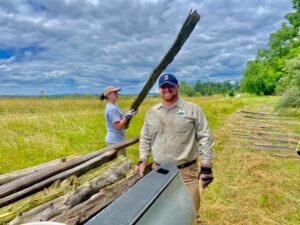
VCCWS interns Jillian Sasso (left) and Miles Abernethy working on the historic fencing at the Winchester battlefield. Photo courtesy of Shenandoah Valley Battlefield Foundation.
This fencing follows fence lines that were present during the battle in 1864, and by recreating these structures, we were helping visitors understand the landscape that the armies fought in. I also worked at several of the museum and historic sites that SVBF operates, especially the Shenandoah Civil War Museum in downtown Winchester. By working at these different sites – I continually honed my skills as a historic interpreter, talking to different audiences and their perspectives on this transformative conflict. Finally, we were given the opportunity to work on our own independent projects. I researched, wrote, and gave and hour-long public presentation on the Louisiana Tigers, a Confederate unit in the Valley that was composed of “marginal” people – which is a direct relationship to my current masters work.
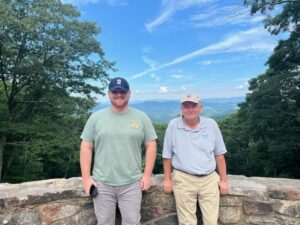
Miles Abernethy (left) and Pete Dalton, one of the volunteers for SVBF, on a tour of the McDowell Battlefield in Bath County, VA.
I want to thank Keven Walker, the staff at SVBF, volunteers Peter Dalton, Jim and Deb Goecker, as well as Dr. Paul Quigley for helping me get set up for this internship – which I am sure will be instrumental in getting me started in the public history community.
10/10/24 — Update from summer intern Jillian Sasso
I spent this past summer working as an intern for the Shenandoah Valley Battlefields Foundation. The variety of work in this internship allowed me to understand exactly how a non-profit battlefield organization operates at each level. Working in multiple environments with everything from battlefield preservation to museum operation, I had the opportunity to expand my own knowledge of Civil War history while also sharing it with the public.


Within battlefield preservation, I worked alongside SVBF staff to restore historic fencing on the Third Winchester Battlefield and helped to conduct any necessary maintenance throughout the Shenandoah Valley. Throughout the summer, I also helped to operate three separate museum locations in the Shenandoah Valley, specifically the Shenandoah Valley Civil War Museum in Winchester, the New Market Battlefield Military Museum and Strayer House Visitor Center in New Market, and the Port Republic Museum in Port Republic. At each of these sites, I interpreted several different topics that spanned the entirety of the Civil War, including military history, civilian life, and local town histories at the various locations. Finally, I worked on numerous programs for SVBF, including a Civil War Traveling Trunk Program and scavenger hunts for the museum sites. The culmination of my personal work during the summer was a lecture that I researched, wrote, and presented to a group of 20 people titled “‘The Tactics of Thrust Before Parry’: Civil War Guerrilla Warfare in the Shenandoah Valley.”
Even though I graduated from Virginia Tech in May 2024, this internship showed me that learning never truly stops. Not only was I able to increase my knowledge of Civil War history, but I also learned more about the local history and culture of the Shenandoah Valley, honed my research and writing skills, and improved my interpersonal communication and presentation abilities. All of these strengths will be useful as I transition into a career with the federal government. A huge thank you goes out to Paul Quigley and the VCCWS for selecting me to complete another internship! It was a great experience to close out my college career!
4/18/24 — Report from the Front: Appomattox Surrender and Freedom Day Events
Last Friday and Saturday, I traveled to Appomattox, VA to experience the commemoration of Surrender and Freedom Day, remembering April 9, 1865, the surrender of Robert E. Lee’s Confederate army, and the emancipation of enslaved peoples across Southside Virginia. It was a unique experience, and from the size of the attending crowds, both the American Civil War Museum Appomattox and Appomattox Court House NHP can expect sizable numbers for next year’s 160th anniversary events. On Friday, I attended the opening ceremony for ACWM-Appomattox’s new traveling exhibit, Greenback America. This exhibit was originally at ACWM-Tredegar, but moved to this site, replacing the Virginia Center for Civil War Studies exhibit in the same space. Greenback America aims to show the importance and changing attitudes over money during the Civil War era. The exhibit was well done and included some fascinating materials, like a Confederate war bond sheet and a Freedmen’s Bureau savings account book. I also got to reconnect with Keith Harvey, the new site director at ACWM-Appomattox. Keith helped me get some materials left over from the VCCWS exhibit and made some introductions to key members of the ACWM board. I hope to collaborate with him in the future!
On Saturday, my dad and I went back to ACWM-Appomattox and partook in the commemorative events there. We watched an artillery firing demonstration, a talk with a reenactor of United States Colored Troops, and a small skirmish reenactment between Union and Confederate troops. Overall, the atmosphere was one of learning and fun for all parties attending. After lunch, we went over to Appomattox Court House NHP, where similar commemorative events were happening. There, we ran into several interpretive staff that I had the pleasure of working with earlier this year: Luke Dixon, who was portraying a Union soldier, Alyssa Holland, busily managing interns, Chris Bingham, who gave a great presentation on the homefront experience of Appomattox, and Lainey Thompson, another volunteer who I worked with. We took in the sights and sounds that we are pretty familiar with, living so close to the park. The final event of the day for us was a talk between two impersonators of Robert E. Lee and Ulysses S. Grant. The impersonations were well done, and both actors definitely looked the part!
I feel that I should reiterate the point of posts like this, as I reflected later that day that most other “civil war centers” do not report on such programming. As someone interested in public history and the Civil War, events like these, as well as talks and lectures are, in my opinion, the keystone of the field. Other topics wax and wane, but the Civil War and its events are remembered and discussed year after year because of events like this in the public space. It takes an army of skilled public historians at federal, state, and private sites around the country to maintain this level of interest. Promoting this career and events like this in academic spaces, where sometimes public history is left out, is critically important for remembering our Civil War history for future generations.
4/9/24 — Reflections on the 159th of Appomattox C.H. by Miles Abernethy
Today, 159 years ago, General Robert E. Lee surrendered to General Ulysses S. Grant at Appomattox Court House. In this incredibly transformative moment, notions of nationalism, warfare, and freedom came together. In extending generous terms to the soldiers of Lee’s Army of Northern Virginia, Grant sowed the seeds for peace when there was a tangible fear of a long, bloody guerilla war in the South. Grant made Lincoln’s “With malice toward none, with charity for all” into practical policy. In surrendering, Lee accepted his futile military situation, and that of the Confederacy at large. Although historians debate his intentions even today, Lee set a moral example for his comrades in putting down the weapons of war. For the enslaved people of Appomattox, April 9 was a day of joy: Freedom Day. Formerly enslaved people could now stake out their own lives out of slavery, but still had to navigate the complex and dangerous era of Reconstruction.
During my winter break this past December and January from Virginia Tech, I volunteered at Appomattox Court House National Historic Park. I wanted to stay busy and connected to Civil War public history, as well as get experience at other National Park Service sites. My previous NPS experience at Fredericksburg Spotsylvania allowed me to quickly get on board the interpretive schedule. Within a couple weeks, I demonstrated to the staff that I was willing and able to interpret both the Visitor Center and the McLean House, where the surrender took place. When you’re working at Appomattox, it doesn’t seem like a worldly place, but thousands of people come from all over the United States to see where our nation’s fate was decided. Like many other Civil War sites, there are common questions that define the working experience, many include what furniture in the “Surrender Room” is original or other specific details. Some of my favorite interpretive situations is when I get to explain the broader context of the end of the Civil War and the role of Appomattox in that process. I can let the passion I have as a student of the war come through as I’m speaking. I had the privilege of also creating an interpretive guide as well. Focused on the art of Appomattox, I created a binder of various depictions of the Appomattox surrender over the past 159 years, showing how artistic license can influence how individuals memorialize and remember the surrender.
I want to give a special thanks to Alyssa Holland, the volunteer coordinator, and the rest of the interpretive staff at Appomattox for making me feel welcome and preparing me to interpret the site. As always, I thank my parents for choosing to live in Appomattox so that I had a bed and home-cooked meals after working at Appomattox C.H. I know that I will continue to volunteer (and possibly work there) if ever possible.
2/27/24 — the Traveling Trunk has returned to the New River Valley
We are so excited to be visiting local elementary schools again this year!
Each spring, history department students and faculty visit fourth-grade classrooms in the New River Valley to bring Civil War history to life. This year, the “Traveling Trunk of Civil War History” is in full swing, with four visits already in the books.
The Traveling Trunk contains clothing, tools, images, documents, and other items that spark the imaginations of younger audiences. And it’s all housed in a replica Union army bread crate. We are looking forward to bringing it to more fourth-grade classrooms soon!
Here are a few pictures from our first visit in February, to Prices Fork Elementary in Blacksburg:
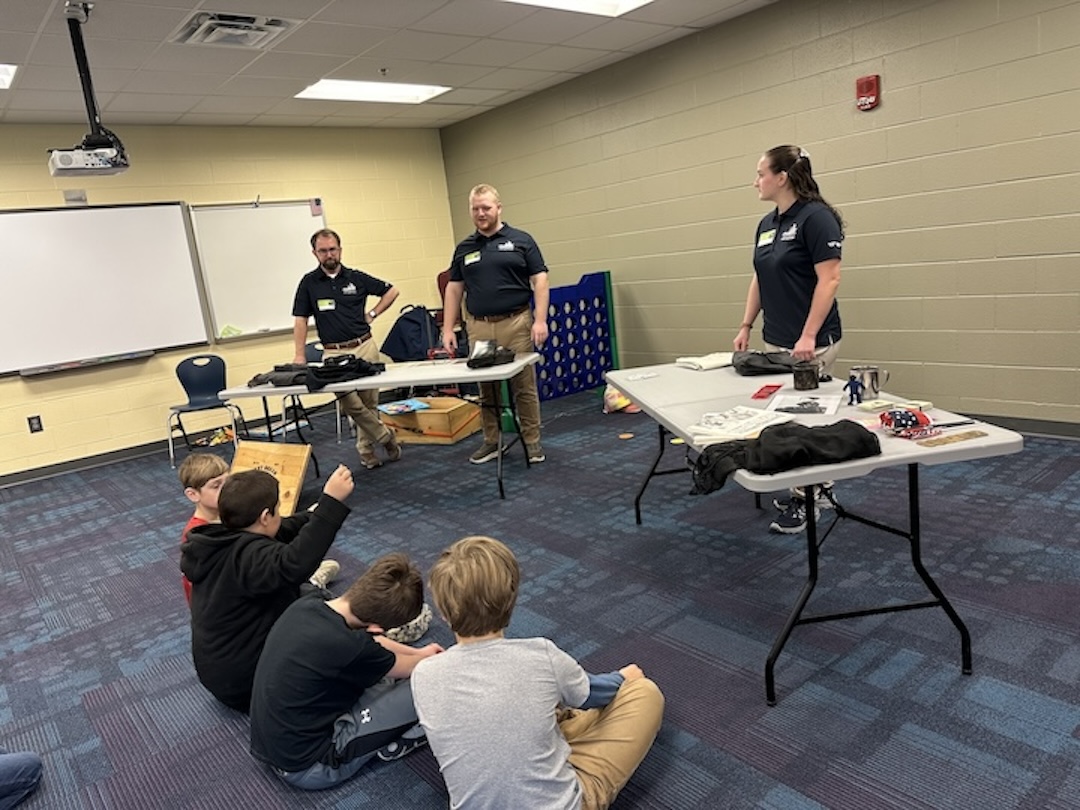
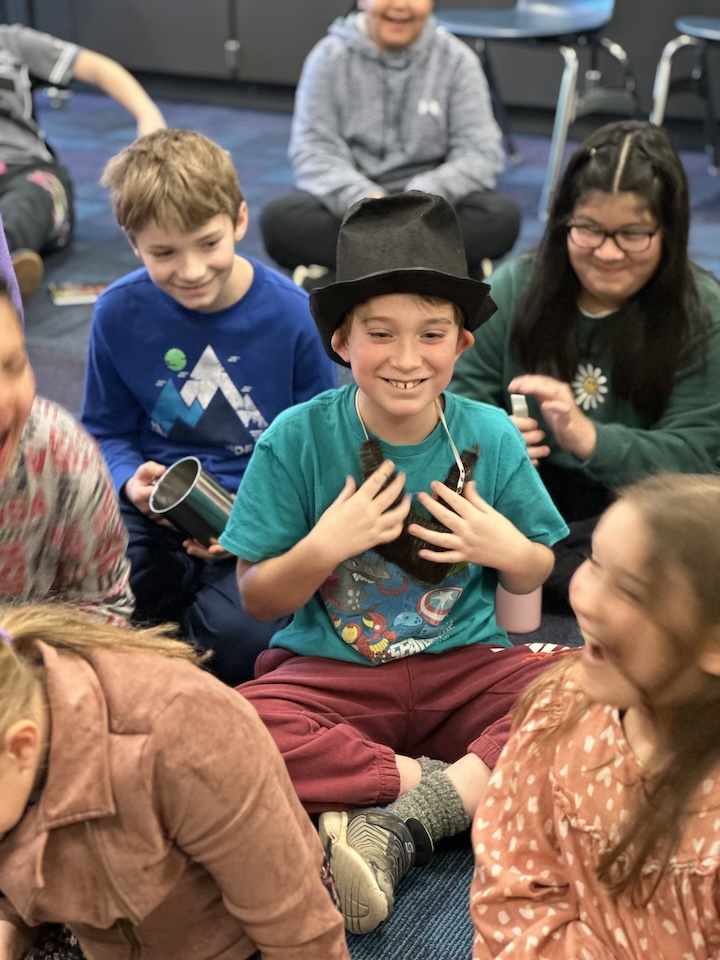
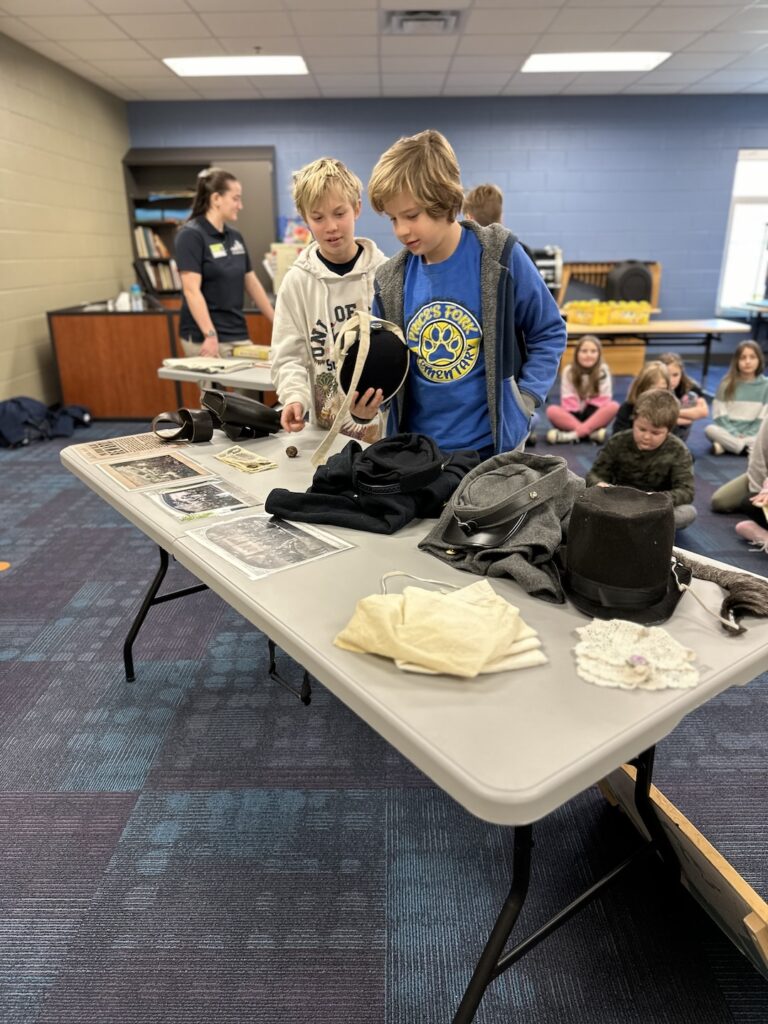
2/8/24 — Report from the Front: Longwood University/Appomattox C.H. NHP 25th Annual Civil War Seminar by Miles Abernethy
Hello everyone, I’m Miles Abernethy, one of the graduate assistants for the Virginia Center for Civil War Studies. You’ve probably seen me on our social media a couple times. I’ve been working with VCCWS since January 2022, first as an undergraduate, and now at the MA level. This is the beginning of a series I’m calling “Report from the Front,” where I post about various things going on in the Civil War world: battlefields, seminars, or other topics. The Civil War primarily engages people in public spaces, and I want to explore them!
Last Saturday, I attended the 25th annual Longwood University/Appomattox C.H. NHP Civil War Seminar, held in Jarman Auditorium on the campus of Longwood University. The topic of the seminar was “Lesser Known Engagements and Some Civil War Photo Sleuthing.” I was actually surprised and a bit annoyed at myself for not knowing about this seminar sooner – it’s practically in my backyard and it’s free! I first learned of it while doing a “winternship” at Appomattox C.H. NHP just this December and January. One of the rangers I worked with, Chris Bingham, mentioned that he would be there. My interest was further piqued when I found out that Virginia Tech’s own Jack Davis and Dr. Kurt Luther would be presenting. I also felt that attending and meeting some other prominent attendees would be ideal, as part of a larger push to “show the flag” of VCCWS to other parts of Virginia.
The first lecture of the day was presented by Jim Morgan, a historian from Charleston, SC who is the author of Six Miles to Charleston, Five Minutes to Hell: The Battle of Secessionville, published by Savas Beatie in 2022. In this operational history of a June 1862 attempt by Federal forces to take Charleston, SC, Morgan explained to us the background of the campaign and the several small battles that made it up. While I haven’t read the book myself, I felt as though the presentation could’ve set this smaller battle into a larger context. For example, the Federal failure in June 1862 caused U.S. forces to consolidate and dig in along the Sea Islands, allowing for initiatives like the Port Royal Experiment, an effort to educate and prepare newly freed enslaved people for life after emancipation. The consolidation of forces also allowed some of the first African-American regiments, including the famous 54th Massachusetts, to prove themselves in battle, in engagements near Secessionville a year later in 1863.
The next lecture concerned a reexamination of the Wilson-Kautz Raid by Zachary Pittard, Director of Education Interpretation at Pamplin Historical Park. I found this lecture intriguing, as I wasn’t super familiar with the Raid and the Battle of Staunton River Bridge. I was pleased to learn about how Southside Virginia was affected by the presence of Federal forces and the war itself coming to the resident’s homes, both free and enslaved.
Next, Virginia Tech’s Dr. Kurt Luther presented the “Civil War Photo Sleuth” project, which seemed to generate a lot of enthusiasm among the attendees. Projects like these are, in my opinion, extremely important to present to large audiences. They show that the Civil War is relevant and innovative, using cutting-edge technologies to understand the war better. Interestingly, he discussed the future of the project, such as using better facial recognition and community consensus infrastructure to better identify pictures. After the presentation, I went and introduced myself to Dr. Luther. We had actually met before, as I had actually assisted him in testing parts of Civil War Photo Sleuth back in December 2020. We had only met over Zoom, so I was really pleased to meet him in person!

After lunch, the former Director of VCCWS, William C. “Jack” Davis, presented on the battles of New Market and Piedmont in 1864. I’ve attended a couple of Mr. Davis’ lectures before, so this one was comfortably easy to understand and I came away satisfied with the importance of these battles within the larger context of the war, and why it is important to study them. In the case of New Market, the presence of the Virginia Military Institute cadets begs questions of the role of manhood and adolescent boys in the Civil War.
Unfortunately after Mr. Davis’ lecture, I had to leave, and was unable to attend the last lecture of the day. Overall, I thought the seminar was informative and I’m glad that it was free for the public. I saw a few people maybe younger than me in the audience, but overall the crowd was older, par for the course in the Civil War community, but something that hopefully can change in coming years. I made some important connections at this conference which I hope will yield for VCCWS. I connected with Joshua Lindamood, the President of the Appomattox Petersburg Preservation Society. APPS is doing important work in preserving the Appomattox Campaign battlefields, and was recently awarded stewardship of the Battle of Appomattox Station site by the American Battlefield Trust. I also connected with Keith Harvey, the recently hired site director at the American Civil War Museum – Appomattox. I want to reach out to Keith and hopefully set up a public history meeting – getting the story of how younger people like him got involved with public history is invaluable for undergraduates and masters students alike.
2/2/24 — 2023 Summer intern Jillian Sasso shares her experience

Jillian Sasso: I spent this past summer working as a Historical Interpretation and Education Intern at Fredericksburg and Spotsylvania National Military Park. Working at Fredericksburg Battlefield Visitor Center, Chatham Manor, and Ellwood Manor, I handed out maps and brochures, provided directions of the park and surrounding area, and interpreted the history of each site to visitors. Additionally, I researched, wrote, and interpreted my own program about the Fredericksburg National Cemetery. Other specialized duties included ancestor research for visitors, operating a cash register, and recording statistics at each site.
Paid intern Jillian Sasso and VCCWS Director Paul Quigley.

Over the course of the summer, I learned so much about the history of the park, including information about Civil War battles, colonial and antebellum historical figures, and even topics such as Civil War memory and interpretation. Most importantly, I learned how to work collaboratively with others in and outside of my division, as well as how to meet the needs of every visitor. I even learned how to fire a 19th century musket and operate numerous stations within Civil War cannon drills!

I am hoping to enter a career field in federal intelligence or the National Park Service, so this internship has been highly valuable for my future. On the academic side, this internship has improved my historical research and writing skills, which will be useful for a career in intelligence or public history. It has also helped me improve my social and communication skills, which I can use to improve my future work environment. I am so thankful to Paul Quigley and the VCCWS for sponsoring this internship! It was a great experience for me.
2/1/24 — 2023 Summer intern Miles Abernethy shares his experience

Virginia Tech graduate student and intern Miles Abernethy and Center Director Paul Quigley.

Miles Abernethy: Working with the National Park Service rangers, staff, and fellow interns at Fredericksburg Spotsylvania NMP has only increased my love for learning about the Civil War and gives me new confidence for a future career in public history.
During my two-and-a-half months with the park, I worked in a variety of roles. From leading large groups on overviews of the Battle of Chancellorsville, to explaining the significance of the “Stonewall” Jackson Death Site, and even analyzing the physical and written quality of the parks signage in the Wilderness Battlefield, my experience was underlined by the excellent training provided to us, allowing me to provide top-notch service to the hundreds of visitors over the busy summer season.
To anyone interested in interpreting the Civil War to a global audience, I highly recommend working with the team at FRSP. They made me feel both welcome and useful – a 10/10 intern experience!


